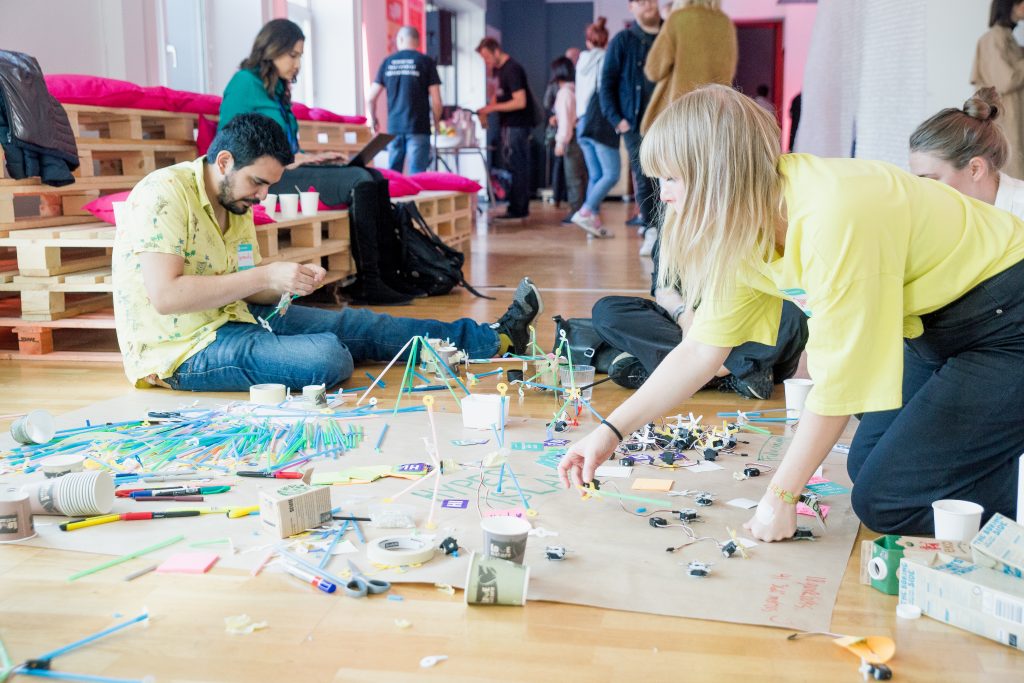Inspiration Aplenty at Gather Festival, Stockholm
Insightful talks and workshops at the intersection of tech, art, science and humanity

For two days in Stockholm, hundreds of individuals assembled for the third Gather Festival in order to listen, contribute to and be inspired by dozens of presentations, workshops and discussions across a broad range of topics. We dropped into the mix to find a refreshingly honest, realistic attitude toward matters affecting our environment, the tech landscape and the role of our workplaces and cities. Oftentimes such events are packed with lofty concepts that leave the brain whirring with anticipation of the new, injected with tinges of fear about what the future will bring for our own steady little lives on planet Earth. At Gather, it felt like if we make an effort, we needn’t worry quite so much.

The event kicked off with a performance of sorts by robot choreographer Robin Jonsson‘s Sony Qrio—which contemplated human interactions and reminded us to hold on to what makes us special. The diminutive robot’s diatribe was at times a little melancholic, breaking into a little sob for a portion of its time on stage.
Lifting things a little was Amsterdam-based producer/musician Chagall, whose compositions are literally woven by the movements of her hands via the MI.MU gloves interface. Surprisingly, for the very switched-on Stockholm audience, Gather’s first speaker was Flat Earth spokesperson Mark K Sargent. Unsurprisingly, there were walkouts from the moment he took the stage. While the Swedes are renowned for their diplomacy, they made their collective belief in science and reason very visible here.
We all have a need to feel and touch, but with digital art the art can be anywhere, which is perfect.
After a workshop on people-driven innovation by the Savvy Design Collaborative, we attended a seminar on the survival of art in the digital age. Here, listeners were treated to an interesting dialogue between curator Marti Manen, photographer Jacob Felländer and emerging digital artist Arvida Byström. Issues of ownership versus the importance of distribution of art brought forth some intriguing ideas. “We all have a need to feel and touch, but with digital art the art can be anywhere, which is perfect,” noted Manen. Overall there was a slight feeling that art’s relationship with digital mediums, channels and formats is still trying to find its sweet spot of acceptance in the eyes of artist, curator, gallery and audience.

We began Gather’s second day with a spirited lab session with Netherlands-based Marcel Kampman whose design and strategy practice Happykamping sees him consult for a multitude of brands. His session explored his personal project, Happyplaces, for which he interviews and films individuals responses when asked, “How do you create space?” Over the past seven years, Kampman has spoken to 700+ people and the interviews can be found on his website. Responses to such an open-ended question are (as can be expected) as fascinating as they are varied.

We headed into Gather’s basement auditorium for Fake It Till You Make It, a talk on creating realities, AI and fake news. Finland’s Sami Niemelä took a look into machine learning as a design tool. While it’s not going to steal any human jobs soon, Niemelä says designers should reign in their aspirations in creating utopias and focus instead on “protopia,” or incremental steps toward improvement but not perfection, as a goal.

Author and researcher, Elizabeth Jochum cast her net over the realities of AI, robots and the human being as an interface between “them and us.” Her presentation was a hard slap in the metal faces of the robots so often prophesied as our future living companions. “Our world is not designed for robots to live in. It’s designed by us for us. If we invited a robot to speak with us now, it wouldn’t even make it onto the stage without our help,” she says. Witty and insightful, Jochum’s experiences from the front lines of robot and artificial intelligence were the highlight of Gather.
Images courtesy of Alric Ljunghager












